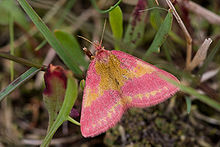Dock-purple spider
| Dock-purple spider | ||||||||||||
|---|---|---|---|---|---|---|---|---|---|---|---|---|

Dock flyworm ( Lythria cruentaria ), male |
||||||||||||
| Systematics | ||||||||||||
|
||||||||||||
| Scientific name | ||||||||||||
| Lythria cruentaria | ||||||||||||
| ( Hufnagel , 1767) |
The dock purple spanner ( Lythria cruentaria ), also simply called purple spanner , sorrel purple spider or bird knotweed purple spanner , is a butterfly from the spanner family (Geometridae).
features
The moths are very variable in drawing and color. Sometimes they can hardly be distinguished from the knotweed purple flyer ( Lythria purpuraria ) and are often confused with this species. The basic color of the forewings ranges from a strong yellow, through light brown to an olive green. There are three red cross bars on the front wings, but mostly the two rear ones are fused to form a wide band. The bandages each reach to the rear edge of the forewings. They are often picked up at the front edge. The red ranges from a strong crimson to a fine pink. In some specimens, the bandages hardly stand out from the basic color. The outer edges are also colored red, corresponding to the color of the bandages. The hind wings are in the same basic color as the forewings, the outer edges are also colored red. In the past, the great variability in color and drawing led to the creation of a whole series of shape types. The moths of the spring and summer generation differ significantly in size and sometimes also in color. The spring generation is much smaller. The proboscis is poorly developed.
The elongated egg, about twice as long as it is wide, is yellowish green. It has an irregular polygonal network structure on the surface. The caterpillars are mostly red-brown on the upper side, but there are also different colored specimens. The side lines are greenish, the ventral side light green to yellowish. The head is brownish with a middle line. The pupa is gray to gray-yellow with four rows of dark colons on the back. The head and abdomen area are often slightly green in color.
Occurrence and habitat
The species is distributed all over Europe, with the exception of the British Isles, the Alps and the Alpine Foreland. It is also rarer in north-west Germany. In the south the distribution area extends from Spain via Sardinia to Italy and the Balkan Peninsula , in the east over the Baltic States and Russia to the Caucasus and the Urals and further to Kazakhstan . It occurs on warm dry meadows, fallow land, sand and heather areas, especially on sandy and rocky soils. In the low mountain ranges they are proven up to about 800 meters, in southern Europe up to 1500 meters.
Way of life
The species flies in two generations from mid-March to May and from June to September, but regionally somewhat different. The eggs are laid on the food plants of the caterpillars, especially the sorrel ( Rumex acetosella ), but also the common sorrel ( Rumex acetosa ). The caterpillars sit on the flowers and fruits from late May to late June and from late August to mid-October. Pupation takes place in a tissue between parts of the plant. The pupa is in the wintering stage.
Systematics and phylogeny
The tribe Lythriini Herbulot, 1962 and thus also the genus Lythria Hübner, 1823 and the species Lythria cruentaria (Hufnagel, 1767) were transferred from the subfamily Larentiinae to the subfamily Sterrhinae in 2008.
According to the phylogeny favored there, Lythria cruentaria is the sister group of a small monophylum consisting of the two species Lythria sanguinaria and Lythria purpuraria . However, the remaining species of the genus Lythria , Lythria plumularia and Lythria venusta could not yet be included in the phylogenetic studies.
Danger
The dock magpie is threatened with extinction in Bavaria and Thuringia, in Hamburg, Lower Saxony and the Rhineland, it is endangered if habitat destruction continues.
swell
Individual evidence
- ↑ a b Red Lists at science4you
- ↑ Erki Õunap, Jaan Viidalepp, Urmas Saarma: Systematic position of Lythriini revised: transferred from Larentiinae to Sterrhinae (Lepidoptera, Geometridae). In: Zoologica Scripta. 4, No. 37, pp. 405-413, Oxford 2008 doi : 10.1111 / j.1463-6409.2008.00327.x
literature
- Arno Bergmann: The large butterflies of Central Germany. Volume 5/1: Spanner. Distribution, forms and communities. Urania-Verlag, Jena 1955, DNB 450378403 .
- Walter Forster , Theodor A. Wohlfahrt : The butterflies of Central Europe. Volume 5: Spanner. (Geometridae). Franckh'sche Verlagshandlung, Stuttgart 1981, ISBN 3-440-04951-5 .
- Günter Ebert (Ed.): The butterflies of Baden-Württemberg. Volume 8, Nachtfalter VI (Spanner (Geometridae) 1st part), Ulmer, Stuttgart 2001. ISBN 3-8001-3497-7 .


